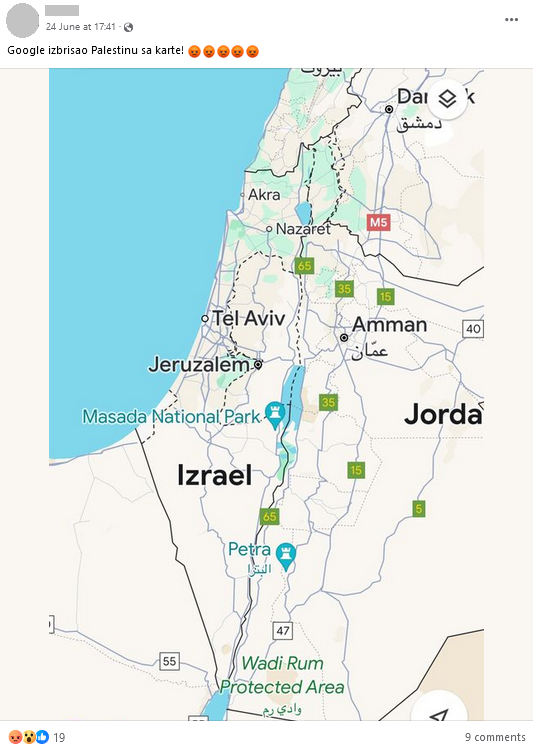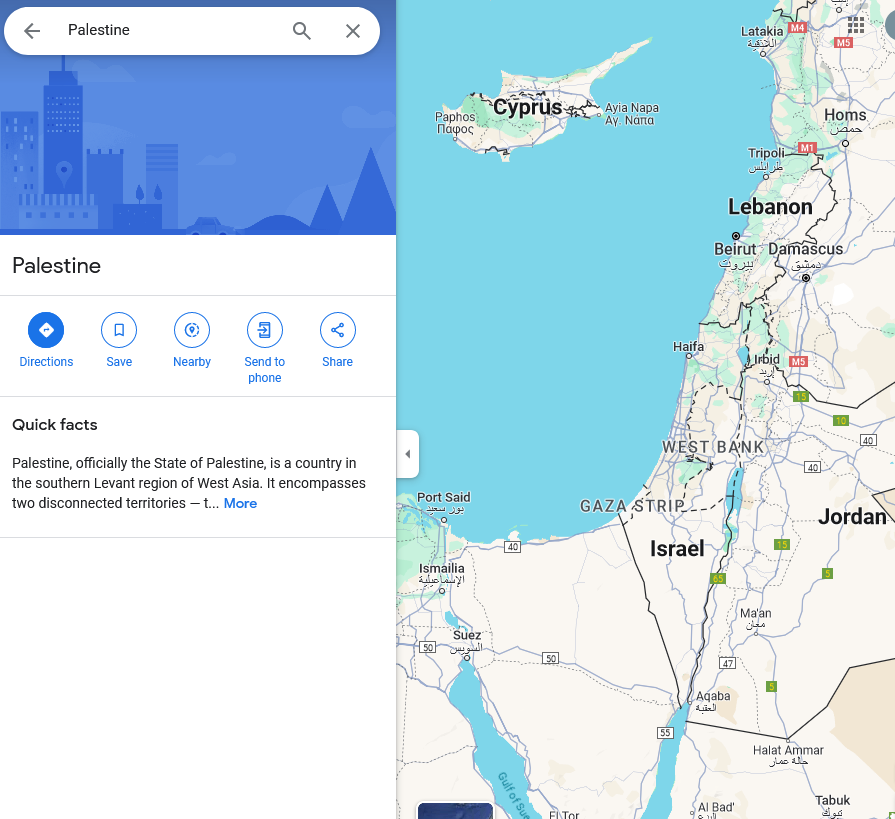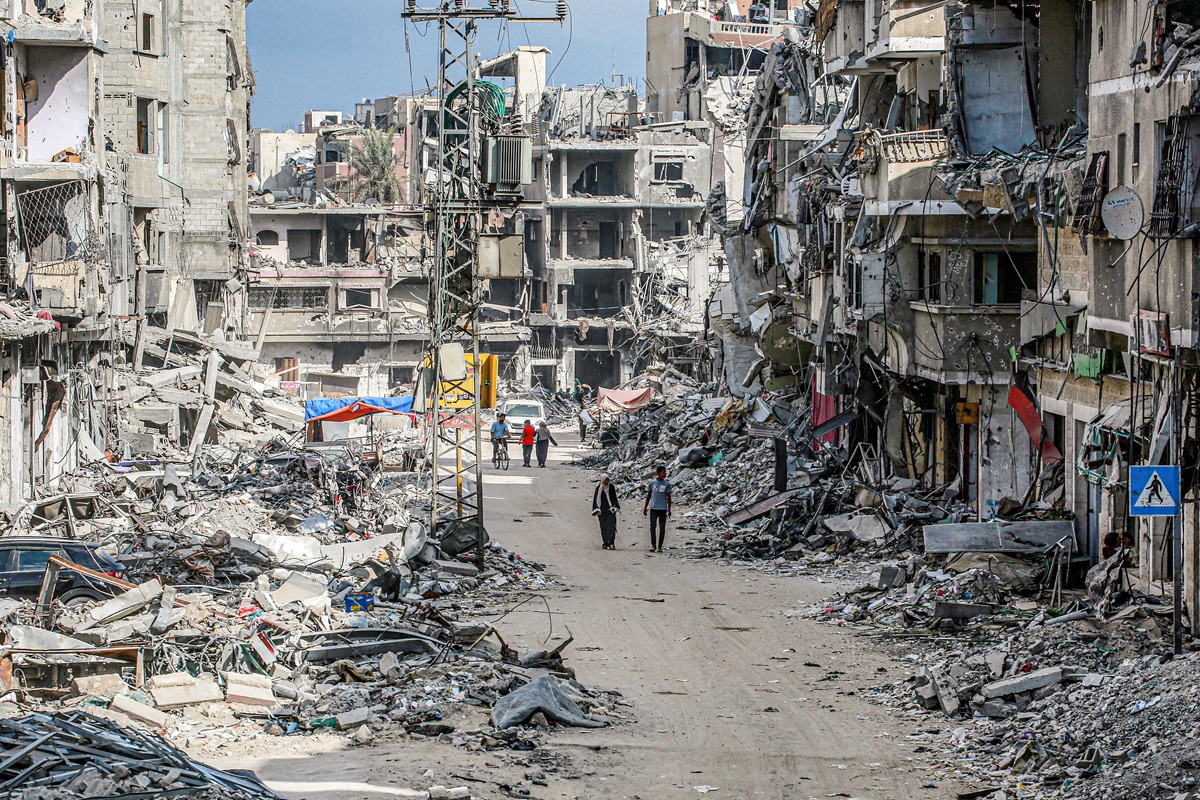Original article (in Croatian) was published on 8/7/2024; Author: Anja Vladisavljević
The borders of the states are marked with a solid grey line, and those determined by the treaty or those that are the subject of a dispute are marked with a dotted grey line.
“Google erased Palestine from the map!”, this is the warning from Facebook posts spreading these days (1, 2, 3).

This claim, although several years old, is spreading again, in the midst of the war that Israel is waging in the Palestinian territory of the Gaza Strip, but also at a time when more and more countries are expressing their intention to recognize a Palestinian state.
Gaza and the West Bank are marked with a dotted line
Google has been accused for some time of erasing Palestine from its maps, but the truth is that the Palestinian territories were never even marked as a state there. The multinational technology company, which has various digital services including – e-mail, search engine, translator, maps – has denied this since 2016, when the information first appeared.
“There was never a ‘Palestine’ label on Google Maps. However, we discovered a bug that removed the ‘West Bank’ and ‘Gaza’ labels. We are urgently working to restore those marks”, spokespeople for the company told several media in 2016 (1, 2).
Palestine itself is not marked on the Google map, but its territories of the West Bank and the Gaza Strip are. They are delimited by a gray dotted line.

“As you explore the world on Google Maps, you can see different styles, borders, and markers”, Google explains on its website. Undisputed international borders, such as that between the United States of America and Canada, are shown as a solid grey line. The gray dotted line marks the borders determined by a contract or similar agreement, but not finalized by law, plus those that are the subject of a dispute.
In addition, this is not the only situation in which Google has a problem with displaying disputed territories. Kosovo, which declared independence in 2008 and is not yet recognized by Serbia, is also marked with a dotted line. Since 2014, users of Google Maps from Russia have seen a solid border around Crimea, a peninsula that Russia annexed and separated from Ukraine. Outside of Russia, Crimea is surrounded by dotted lines, marking it as occupied territory.
Is the establishment of a Palestinian state likely to happen?
Efforts to create a Palestinian state on the West Bank of the Jordan River and Gaza on the Mediterranean coast have been thwarted by the ongoing conflict with Israel. The State of Israel was proclaimed in 1948, after which five Arab states attacked it. The war ended with Israel controlling 77 percent of the territory. Over 700,000 Palestinians have fled or been driven from their homes, ending up in Jordan, Lebanon and Syria, as well as the Gaza Strip, the West Bank and East Jerusalem.
Israel occupied the West Bank in the 1967 war and drove another 300,000 Palestinians from their homes. They continue to be expelled today, and their land is often taken over by Israeli settlers. The Palestinians fear that this diminishes their chances of establishing a state, and the United Nations (UN) unequivocally considers the establishment and maintenance of Israeli settlements in the area of East Jerusalem and the West Bank to be illegal and illegitimate under international law.
In addition to the physical separation of the Palestinian territories, their political situation also distinguishes them. The West Bank is ruled by the Fatah party, which recognizes Israel’s right to exist and is seen by most Western countries as the political representative of the Palestinians. The Gaza Strip has been ruled by the militant Islamist Hamas since 2007, which launched a multiple attack on Israel on October 7, 2023. Hamas otherwise rejects the peace process with Israel. Gaza has been under attack by the Israeli army since October, following the Hamas action.
The two-state solution has become a widely accepted idea at the international level (also advocated by the UN), although Israelis and Palestinians increasingly see it as impossible. Proponents of the two-state solution envisioned a Palestinian state in the Gaza Strip and the West Bank connected by a corridor through Israel. There are many obstacles to the realization of such an idea.
Apart from the problem of the occupied and fragmented territory in the West Bank, there is the question of what will happen to Gaza. From October to the beginning of this month, over 38,000 Palestinians were killed, 1.9 million were displaced, and over 360,000 residential buildings were destroyed. The population of Gaza lives in a strict blockade, without food, water and medicine. Israel claims that the ultimate goal of the war is the destruction of Hamas, but it is not known who will take control of the area and how.
More and more countries are recognizing Palestine
Due to the catastrophic humanitarian situation in Gaza, which is why Israel is facing a charge of genocide before the International Court of Justice, more and more countries and public figures are advocating a ceasefire and condemning Israeli aggression. These calls especially intensified after Israel disobeyed the order of the International Court of Justice to stop military attacks on the south of Gaza, the area of the city of Rafah, which is located on the border with Egypt, and where about 1.4 million Palestinian refugees are located.
At the diplomatic level, Palestine is gaining momentum. In May, the UN General Assembly supported the Palestinian candidacy for full membership in the organization. The resolution of the General Assembly, which was then adopted in September of this year, will allow the Palestinians some additional rights, such as a place among the UN members in the assembly hall. However, they will not be given a vote in that body.
Since 1988, when the leader of the Palestine Liberation Organization (PLO) Yasser Arafat declared the “establishment of the State of Palestine”, about 140 countries have already recognized Palestine, more than two-thirds of the members of the United Nations. The last among them was Armenia, which did so on June 21, 2024. According to WAFA, the Palestinian news agency, Armenia is the 149th out of 193 UN members to recognize Palestine.
In Europe, Spain and Ireland have launched an initiative to recognize Palestine as a state and other European countries are joining it. The United States of America and other Western powers did not join them. Experts are reserved about the significance of the individual recognition of Palestine. As the web portal USA Today wrote, for Palestine to qualify as a state in the modern sense of the word, it needs to have a permanent population, a defined territory, a government and independence, and, at the moment, it does not fulfil any of these.
It remains uncertain if and when Palestine will be marked by a solid line on Google. We know it hasn’t happened yet.



